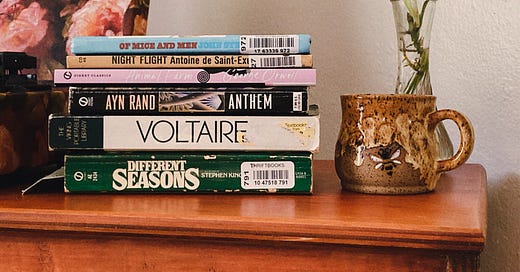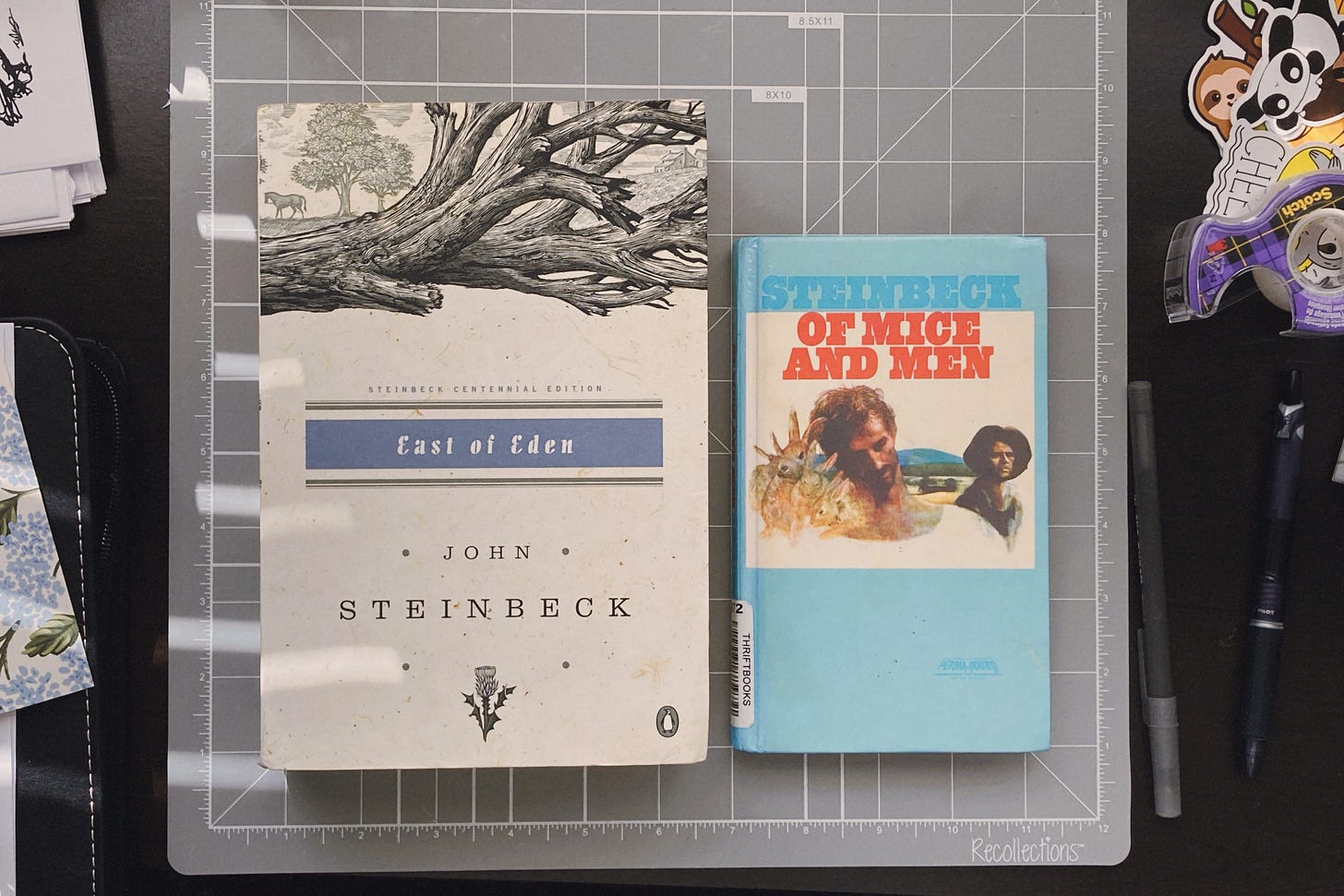Maybe try a smaller book
Just like with coffee, more isn't always better; plus, six novella recommendations
Scroll to the end if you’d just like the recommendations! Thanks for reading!
Maybe you have a coffee order that’s the same no matter where you go. I do. For the last few years, my default is a cortado. It’s a shot of espresso cut with an equal amount of steamed milk - sort of a latte with less milk but the same amount of espresso. (Illustration + sneak peek into how this relates to books below.)
I’ve grown to love these as a middle ground - the golden mean between drinking a straight shot of espresso (too intense!) and drinking sixteen ounces of warm milk (too much dairy!). Plus, they always come in a cool glass that makes me feel like I’m Marion Ravenwood in Raiders of the Lost Ark.
So, what does the size of a coffee have to do with art?
Coffee might come in easily labeled sizes, but books usually don’t. Even page count isn’t the most reliable indicator, since formatting and font sizes can vary so widely. I’ve found that when I’m not consciously thinking about it, I categorize books into two categories - “normal” books and “big” books.
A big book is any book that you’d look at and say, Wow, that’s a big book. I’m talking Moby Dick, Les Misérables, Atlas Shrugged, and of course The Count of Monte Cristo. They are mammoths - in their page count, through their shelf presence, and by the sheer density of their contents and style. Their names inspire awe and fear.
A normal book is any other book.
Right? There are giant books that I might read someday before I die, and there are normal books that I could read this month. This is how I view the world of literature when I’m not thinking too hard about it.
But while this simple categorization works for coffee, and even some art (say, movies) I don’t think it really works for books.
Let’s use movies as an example.
The structure of “big” and “normal” applies pretty well to movies (at least I think so). There are normal movies (an hour and a half to two hours), and then there are big movies (two and a half hours to three and a half hours).
Watching The Iron Giant (a very short movie) takes about an hour and a half; watching Lawrence of Arabia (a very long movie) takes almost four hours. In other words, you could watch The Iron Giant about 2.5 times in the same time as it took to watch Lawrence of Arabia. (I’d happily recommend both movies to you, by the way, although for totally different reasons.)
Compare this to a few books: John Steinbeck’s Of Mice and Men is about 30,000 words; his novel East of Eden is about 225,000 words. That’s 7.5 times as long.1
Anthem by Ayn Rand is a little over 20,000 words long; her book Atlas Shrugged is about 550,000. That’s 27.5 times as long.
But the point here isn’t to flash numbers around to prove that some books are bigger than others. I know we already knew that :)
I just want to remind myself that the difference in length between a short book and a long book can be far, far greater than the difference in length between a short movie and a long movie. (Or the difference in size between a tall and a venti.)
An illustrated guide
Before I make my recommendations to you, let me try and illustrate what I’m thinking here: please enjoy the Official Tim DeMoss Movie-to-Book-to-Coffee Comparison Chart.
As you can hopefully see on the right end of the spectrum, I think bigger books like The Count of Monte Cristo with their sweeping narratives and ensemble casts are really more comparable to TV shows than they are to movies. Even normal-sized novels, like Pride and Prejudice, I’d say more closely parallel a mini-series than a single movie (which, by the way, I can’t recommend the 1995 BBC Pride and Prejudice mini-series enough! Seriously, I think you’d love it!).
And on the far left of the spectrum, you’ll see short stories being compared to short films. (It’s even in the name.) Maybe you read The Monkey’s Paw or To Build a Fire in high school. They’re stories, they’re short. Just like espresso, you get the bare bones of the story and there isn’t time for much else. It’s condensed and to the point. You get it.
But it’s the movie/novella/cortado comparison I want to dwell on.
The novella; somewhere in between
Quick definition: Wikipedia tells me a novella is between 17,500 and 40,000 words. It also tells me there is “disagreement” on this definition, so make of it what you will. Merriam-Webster tells me a somewhat more helpful definition: a work of fiction intermediate in length and complexity between a short story and a novel.
To me, the novella and the cortado hit a sweet spot. There’s just enough to satisfy what I need without overwhelming me or underdelivering. There’s a potency and strength mixed with consumability. I love it.
Don’t get me wrong - I love novels and big chunky books too! In fact, most of my favorite books have been giants that I’ve needed to work through. And what you read really depends on what you’re looking for in a book. But the re-discovery that I could still get a bookish experience from something shorter was wonderful to me.
So today, what I’d like to recommend to you is this: you might like reading a novella.
And finally, some specific recommendations
Here are some novellas I’ve read recently that you might like, recommended in no particular order.2 All of these could fairly easily be read in an afternoon, but of course you might want to take them slower. And of course, remember - you might like these. You know your own reading tastes better than I do. :)
Anthem by Ayn Rand (1938). If you’re not familiar with Rand, she’s a very interesting character and I’d say well worth reading - if only to discover where you agree and disagree with her philosophy. Anthem is a dystopian story regarding a future age where individualism has been denounced as the greatest sin. Be prepared to be inspired, angered, or both.
Rita Hayworth and Shawshank Redemption by Stephen King (1982). This is the story that The Shawshank Redemption (1994) is based on. If you loved the movie, I think you’ll love the novella. I was shocked at how closely the movie paralleled the book - even down to specific exchanges and lines of dialogue (“Since I am innocent of this crime, sir…”). This book cemented in my mind the comparison between the novella and a standard movie and helped me realize that a longer book is probably more similar to a mini-series.
Of Mice and Men by John Steinbeck (1937). This story was heartbreaking and beautiful and awful. You may have been required to read this in school - if you were, I’d really recommend reading it again without the label of homework. It made me think heavily about plans I have for my future, what I’m doing to make them happen, and the friends and family I want to bring with me.
Candide by Voltaire (1759). This book is brutal. It’s funny, too, but in a horrible way. Candide is a satire whose apparent sole purpose it to poke holes in the theory that we live in “the best of all possible worlds” - i.e., whatever happens, must be for the best, because if it was not, then God would not have allowed it. Be prepared for worse and worse things to happen each chapter, and for the character to struggle to figure out how this could possibly be for the best. I liked the audiobook version of this on Spotify.
Animal Farm by George Orwell (1945). This is another one that I would recommend re-reading even if you were assigned it in school. It’s shorter, more disturbing, and more relevant than you probably remember - at least, that’s what I found when I reread it this week. I don’t usually use the word “gaslight” in regular conversation…but it came to mind maybe every three or four pages when reading this book.
Night Flight by Antoine de St. Exupéry (1931). I finished it just last night, so my thoughts on this are still swimming. On the surface, it’s the story of a nighttime airmail flight trapped in a storm, and the ground crew trying to assist. However, it’s mostly an emotional and philosophical work asking: Can we justify the sacrifice of the individual in pursuit of a greater good? I found Rivière (the station chief) to be one of the most interesting and memorable characters I’ve read in a very long time; his internal thoughts make up a good portion of the story.
That’s all for today! Thanks so much for reading :) If there’s a novella that you’ve enjoyed, feel free to drop it in the comments below! I’d love to hear your recommendations.
All the best,
Tim
Finding exact word counts is harder than I’d thought. When the first three results on Google give wildly different numbers, I get suspicious. I wish I could say I went back through the books and counted the words by hand, but I unfortunately did not have the time. I did a little digging online instead, and I hope these numbers are accurate enough.
I’ve included Thriftbooks links to each book, but be aware there are a lot of different versions, so double-check if you plan on buying that you’re not accidentally ending up with something weird! :) These aren’t affiliate links, just me linking you to where I’d usually buy from. You’re of course welcome to purchase them anywhere else or get them from the library.









Thank you for the recommendations! I will add them all to my ever-growing book list, (except Animal Farm because I've already read that one.) It's funny how no matter how many books I read, my list still doesn't get any smaller. Like, for every book I read, five more are added to my to-read pile.
I like these recommendations! I've added some of them to my to-be-read list just now. I loved 1984 (even when I had to read it as homework, I simply couldn't put it down once I got into it), so I think I might like Animal Farm as well. Anthem and Candide sound interesting too!